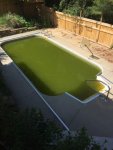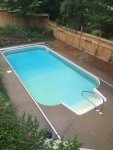I am going to throw my .02 cents in here as I am a noob as clearly noted by my info tag. June of 2017.
I think the debate needs clarification.
Are we debating that one can achieve clear water with Aquacheck guess strips or are we debating that one can achieve CLEARER & SAFER water with TFP methods and an approved Test Kit.
I have owned and managed my pool for the last 13 years. Every year prior to 2017 I used the Aquacheck 7 test strips.
My avatar is a picture from August 1, 2015 (I was still in guess strip use), I took that picture because that was the best the pool had looked that season up that point. We typically open in Mid May... so it took me ~2.5 months to get it to that point.
I live in Southern Indiana, we have a 3 - 3.5 month swim window (we do not have a heater [yet], so I spent 71% of my swim time to get my pool to my end goal.
This year, I have done the same in 3 weeks or approximately 20% of my swim time, (and could have done it faster had I recognized my filter issue a week sooner), but I will accept the full 21 days.. I will "give" that time away and I still accomplished my goal in 1/3 of my personal average experience & time.
Now, I will not argue that accomplishing a clear pool with strips is not possible. It is, I did it for 12 years. I will absolutely argue that the money I spent this year and the time it took me to accomplish this points to me that the methods work. Not only do they work but they work better and faster than any strip test method I have used in 12 years with the same pool.
Probably what tipped me over the point to TFP was I asked myself ... IF my Local Board of Health uses a Test Kit and NOT strips to check water at my YMCA & if I really care about the health of my family then why in the world would I do anything LESS? For me, I decided that I wouldn't, I won't and thanks to TFP I don't have to.
A few things to think about in the strips vs test kit debate,
Do strips work? Define work. They change color, yes.
Are strips reliable? Define reliable. They give you a range but that range changes with exposure (sometimes) quickly.
What does your Board of Health use?
Do you have access to acquire this same test kit the BoH uses and easily learn the methods? Yes
One Final question.
If your family got sick at a water park and you found out that they did not use "THE" Standard Testing Method, would you expect a Criminal Case (I expect the Board of Health would be interested)? Do you think you would have a Civil Case?
These are the questions I asked myself.
I did not ask can it be done. More importantly to me, what are the safest and healthiest methods available to me.
Summary,
I had no idea that Liquid Chlorine is the same active ingredient as Regular Bleach and that only the % strengths were different. I did not "know" that until I read the MSDS (Material Data Safety Sheet) of the products. I did not realize that TA up was sodium Bi-Carbonate until I read the MSDS. This is no different than me not knowing what my YMCA uses to test their water to pass inspection.
As noted earlier, it's your pool, you should do what you think is best, but there IS a definitive answer from a Legally Authorized Department that can and will shut down a pool based on the results of THEIR testing methods. Their Test results are not based on strips (in my County). These are the only facts that I needed to know.
My pool June 2 2017

June 23

Some work to clean up the organic stains is all that is left.
Not strips
No Algaecide
No Floc
No Clarifier
No "bag shock"
TFP SLAM methodology and my Taylor k2006 test kit.
Hope this helps others,




